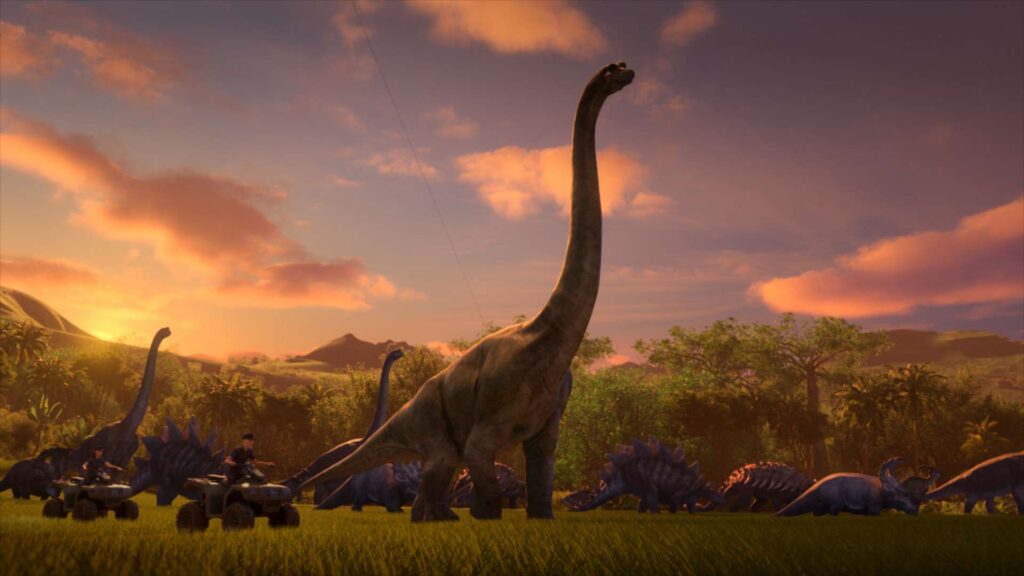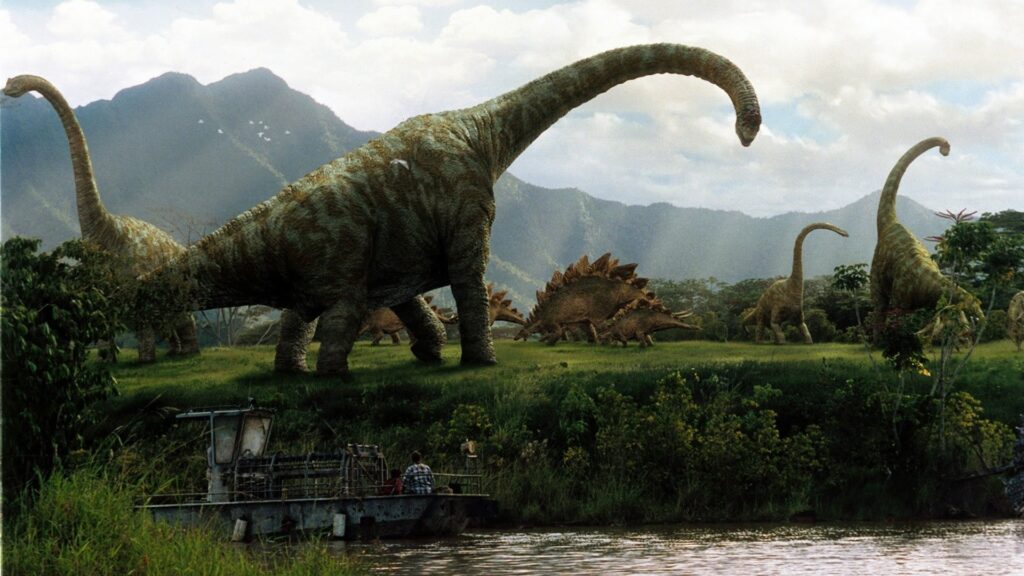The Jurassic Park franchise has captivated audiences worldwide, taking them on a thrilling journey into the prehistoric past. Since its debut in 1993, these films have left an indelible mark on popular culture, igniting a fascination with the world of dinosaurs and unleashing our imaginations. From the awe-inspiring visual effects to the iconic roar of the Tyrannosaurus Rex, Jurassic Park has become a cultural phenomenon that continues to enthrall audiences of all ages.
With its groundbreaking storytelling and cinematic prowess, the Jurassic Park franchise has amassed a dedicated fanbase and garnered immense critical acclaim. These films not only revolutionized special effects in the industry but also sparked a renewed interest in paleontology and the mysteries of our planet’s history.
In this article, we embark on an exciting exploration of the Jurassic Park movies, delving into each installment’s unique storyline, memorable characters, and mesmerizing dinosaur encounters. We’ll delve into the origins of the franchise, highlight its enduring popularity, and discuss the impact it has had on subsequent films and pop culture.
Get ready to embark on a journey into the past, where ancient creatures roam the screen and adventure awaits around every corner. Let’s dive into the awe-inspiring world of Jurassic Park and discover why these movies have become a timeless adventure that continues to captivate audiences to this day.

The Origin of Jurassic Park: Unveiling the Classic
In 1993, the world was introduced to the phenomenon known as Jurassic Park. Directed by the visionary filmmaker Steven Spielberg, this groundbreaking movie brought prehistoric creatures back to life on the big screen in a way never seen before. The release of Jurassic Park marked a significant milestone in the realm of science fiction and adventure films.
Directed by Spielberg, a master storyteller and pioneer in the film industry, Jurassic Park captured the imagination of audiences worldwide. Spielberg’s ability to craft compelling narratives blended seamlessly with his passion for visual effects and cinematic storytelling. With his meticulous attention to detail, he transformed Michael Crichton’s novel into a thrilling and unforgettable film experience.
One of the most remarkable aspects of Jurassic Park was its groundbreaking special effects. Through the skillful use of animatronics and state-of-the-art computer-generated imagery (CGI), the film brought dinosaurs to life with astonishing realism. The sight of the mighty Tyrannosaurus rex roaring on screen or the gentle Brachiosaurus munching on leaves captivated audiences of all ages.
The impact of Jurassic Park’s special effects reverberated throughout the film industry, forever changing the way movies used CGI. Audiences were left in awe, witnessing the seamless integration of visual effects with live-action footage. The movie showcased that technology could be harnessed to create awe-inspiring and immersive worlds.
Jurassic Park’s success not only stemmed from its technical achievements but also from its ability to create a sense of wonder and adventure. It transported viewers to an island filled with danger and discovery, igniting their imaginations and sparking a newfound fascination with dinosaurs. The film’s impact continues to resonate even decades later, as it remains a beloved classic cherished by fans around the world.


Jurassic Park: The Lost World – Expanding the Prehistoric Universe
In the ever-evolving world of Jurassic Park, the sequel titled “The Lost World” took audiences on another thrilling adventure. Released in 1997, this highly anticipated follow-up to the original jurassic expedition captivated viewers once again. Directed by Steven Spielberg, the film received both critical acclaim and commercial success, solidifying its place in the franchise’s history.
“The Lost World” introduced a fresh array of characters and locations to the prehistoric universe. Audiences were introduced to Dr. Ian Malcolm’s (played by Jeff Goldblum) return, taking the lead as the central protagonist. Accompanying him were familiar faces like Sarah Harding (played by Julianne Moore), a fearless and determined paleontologist.
This time, the action-packed story took place on Isla Sorna, also known as Site B. The film delved deeper into the unexplored territories of the dinosaur-inhabited island, providing a thrilling backdrop for the unfolding narrative. Spectacular set pieces, such as the high-stakes pursuit through a fleet of trailers or the intense encounter with a T-Rex in the city, exemplified the film’s commitment to delivering memorable moments of excitement and suspense.
From exhilarating velociraptor chases to heart-pounding encounters with new breeds of dinosaurs, “The Lost World” showcased an expansion of the prehistoric universe established in the original film. Spielberg’s masterful direction and the stunning visual effects brought these ancient creatures to life once again, mesmerizing audiences with their awe-inspiring presence.
True to its name, “The Lost World” allowed viewers to immerse themselves in a captivating adventure with higher stakes and grandeur. The film successfully built upon the foundation laid by its predecessor, expanding the Jurassic Park lore and leaving an indelible mark on the franchise’s legacy.
Jurassic Park III: A Return to Island Adventures
Jurassic Park III marked the return of the beloved paleontologist Dr. Alan Grant, portrayed once again by the talented Sam Neill. Released in 2001, this third installment in the Jurassic Park series brought back the thrill and excitement of dinosaur-filled adventures on the remote Isla Sorna.
When Jurassic Park III hit theaters, fans were eager to join Dr. Alan Grant as he found himself immersed in yet another survival quest amidst prehistoric creatures. The film received mixed reviews, with some praising the tense and action-packed storyline, while others felt it didn’t quite reach the heights of its predecessors.
What set Jurassic Park III apart was its focus on the survival aspect. Stranded on Isla Sorna, Dr. Alan Grant and a group of unexpected allies must navigate through treacherous terrain while evading carnivorous dinosaurs at every turn. This exploration of adventure and survival added a new layer of excitement to the franchise.
One standout moment in the film is when the characters find themselves chased through a gigantic aviary filled with flying dinosaurs. The heart-pounding sequence showcases the peril and danger that surrounded the characters, giving the audience an adrenaline rush. This scene remains etched in the memory of many Jurassic Park fans.
While Jurassic Park III may have received some criticism, it undeniably contributed to the overall narrative of the franchise. Dr. Alan Grant’s return brought a sense of continuity and allowed fans to continue his thrilling journey. The film’s emphasis on survival and adventure added a fresh perspective to the Jurassic Park universe, showcasing the diversity of the prehistoric world beyond the confines of the park.


The Revival: Jurassic World Brings the Park Back to Life
After a hiatus from the big screen, the Jurassic Park franchise roared back to life with the highly anticipated release of Jurassic World. Directed by Colin Trevorrow, this film served as a direct sequel to the original Jurassic Park trilogy while introducing a bold new concept that captivated audiences worldwide.
Jurassic World took audiences on an exhilarating journey back to Isla Nublar, where a fully operational dinosaur theme park called Jurassic World had been established. This ambitious park concept, filled with awe-inspiring attractions and genetically engineered dinosaurs, aimed to push the boundaries of entertainment. However, as with any grand endeavor, consequences awaited.
The film meticulously showcased the consequences of the park’s creation, delving into the ethical implications of genetic manipulation and the dangers associated with playing god. It masterfully explored the delicate balance between humans and dinosaurs and the chaos that ensued when that equilibrium was disrupted.
Furthermore, Jurassic World introduced a new generation of characters that would leave a lasting impact on the franchise. Chris Pratt’s charismatic performance as Owen Grady, a raptor trainer, became an instant fan favorite. Bryce Dallas Howard’s portrayal of Claire Dearing, the park’s operations manager, provided a strong, determined female lead.
The film’s success was undeniable, becoming a box office phenomenon and reigniting the passion of both longtime fans and newcomers to the Jurassic Park universe. Jurassic World not only revitalized the franchise but also set the stage for future installments, demonstrating that the awe and wonder of dinosaurs still held a special place in the hearts of audiences worldwide.
Jurassic World: Fallen Kingdom – Evolution and Destruction
The release of the sequel, Jurassic World: Fallen Kingdom, marked a significant shift in tone for the franchise. Departing from the adventure-driven narrative of its predecessor, this installment delved into a darker and more suspenseful storyline. The reception among audiences and critics varied, with some praising the film’s bold direction while others yearned for the nostalgia of the original Jurassic Park.
Fallen Kingdom continued to explore the ethical implications of creating and manipulating prehistoric creatures. The film delved deeper into the idea that humans playing god with genetic modification can have disastrous consequences. The narrative took a thought-provoking turn as it examined the ethics of cloning and the responsibility that comes with tampering with nature.
One of the standout aspects of Fallen Kingdom was its ability to immerse viewers in a more menacing and foreboding atmosphere. The stakes were higher, and the tension was palpable as the characters faced not only the threat of rampaging dinosaurs but also the exploitation of these creatures for profit.
The film’s use of special effects and visual storytelling further enhanced the sense of danger and destruction. From the engulfing volcanic eruptions to the harrowing encounter with a new genetically modified dinosaur, Fallen Kingdom showcased the franchise’s ability to push the boundaries of CGI and immerse audiences in a thrilling cinematic experience.
Overall, Jurassic World: Fallen Kingdom offered a compelling exploration of the darker side of genetic manipulation and the potential perils that come with it. While it may have divided opinions, there is no denying the impact it had in advancing the overarching narrative of the Jurassic Park franchise. With its evolution and destruction themes, this installment set the stage for the epic conclusion in Jurassic World: Dominion.
Jurassic World: Dominion – An Epic Conclusion and Beyond
Looking ahead to the highly anticipated film, Jurassic World: Dominion, fans are buzzing with excitement as the franchise prepares for an epic conclusion and a new chapter in the prehistoric saga. Building upon the success of its predecessors, Dominion promises to deliver a thrilling adventure that will leave audiences on the edge of their seats.
One of the most exciting aspects of Jurassic World: Dominion is the return of iconic characters from the earlier films. Fans will have the chance to reunite with beloved favorites such as Dr. Alan Grant, portrayed once again by the talented Sam Neill, as well as Dr. Ellie Sattler and Dr. Ian Malcolm. This reunion not only adds a nostalgic touch to the film but also offers a sense of continuity, bridging the gap between the original Jurassic Park trilogy and the more recent Jurassic World installments.
But it’s not just about the familiar faces. Dominion aims to expand the story and push the boundaries of the Jurassic Park universe further. The film takes us beyond the confines of the theme park setting and into a world where dinosaurs roam freely, interacting with the modern world. This bold and ambitious step opens up a realm of possibilities, highlighting the coexistence and conflicts between humans and these prehistoric creatures in an entirely new way.
The anticipation and expectations surrounding Jurassic World: Dominion are unprecedented. Fans are eagerly awaiting the release of this cinematic spectacle, yearning to witness the epic conclusion of the current storyline while also experiencing the captivating introduction of fresh narratives and thrilling plot twists. With each new installment, the Jurassic Park franchise continues to captivate and thrill audiences, maintaining its status as an iconic and beloved series.


Conclusion: A Timeless Adventure Worth Revisiting
Jurassic Park pioneered groundbreaking visual effects and storytelling,
setting a new standard for the film industry. Its success paved the way
for advancements in CGI technology and propelled the development of
immersive cinematic experiences.
The franchise’s influence can be seen in the plethora of dinosaur-related
media that followed, ranging from documentaries to video games. Jurassic
Park inspired a generation’s fascination with prehistoric creatures,
captivating audiences of all ages and nurturing a dedicated fanbase that
continues to thrive today.
As we reflect on the journey through these captivating films, we are
reminded of the lasting appeal and importance of the Jurassic Park
franchise. It encapsulates our collective fascination with the past, our
curiosity about the natural world, and our love for thrilling adventures.
We encourage both loyal fans and newcomers alike to revisit or explore the
Jurassic Park movies, as they offer an unforgettable and exhilarating trip
into the past.
FAQs
1. Are the Jurassic Park movies based on a book series? Yes, the Jurassic Park movies are based on the book series written by Michael Crichton. The first movie is a direct adaptation of Crichton’s novel of the same name.
2. How many Jurassic Park movies are there? Currently, there are five Jurassic Park movies. These include the original trilogy (Jurassic Park, The Lost World: Jurassic Park, and Jurassic Park III), as well as the newer installments, Jurassic World and Jurassic World: Fallen Kingdom.
3. Do I need to watch the Jurassic Park movies in order? While each movie can be enjoyed as a standalone experience, watching the Jurassic Park movies in order will provide a more comprehensive understanding of the overarching story and character development.
4. Are the Jurassic Park movies suitable for all ages? The Jurassic Park movies are generally considered appropriate for older children and adults. They contain intense action sequences and mild violence. Parents or guardians may want to review the content and suitability for younger viewers.
5. Will there be more Jurassic Park movies in the future? Yes, there is an upcoming movie called Jurassic World: Dominion, which is set to continue the story and serve as an epic conclusion to the Jurassic Park franchise. After that, it is possible that more movies or spin-offs may be developed.












